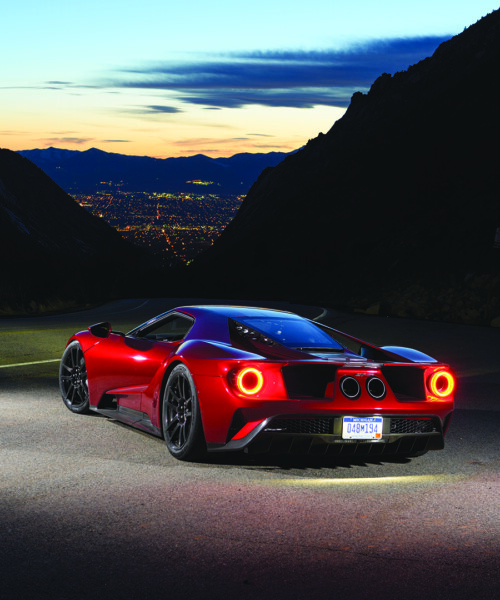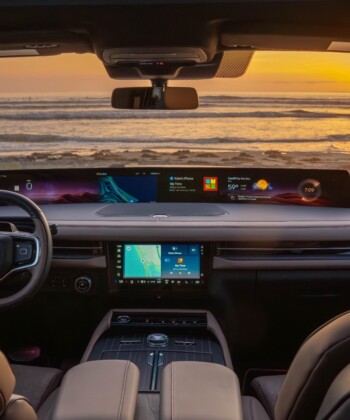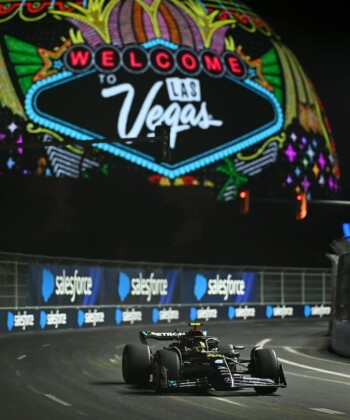Ford GT
If the idea of a Ferrari-baiting Ford is foreign to you, I recommend studying up on the epic rivalry between Ford and Ferrari in the late 1960s. At the very least, you’ll appear highly informed when a rumored movie starring Christian Bale and Matt Damon brings the drama to the big screen in the next year or two, and you’ll also learn how Ford smacked the Prancing Horse around a bit with its radical GT40, the spiritual and stylistic progenitor to the new Ford GT. With carefully designed aerodynamics, dramatic flying buttresses, a 647-horsepower engine mounted behind the cabin, and dihedral doors that open like a swan taking flight, the GT is the GT40’s proper super sportscar successor. Ford will build no more than 1,000 by 2020. Current price: $453,750.
Aston Martin DBS Superleggera
Every V-12-powered Aston Martin is pretty damn super, and today’s $244,081 DB11 is no exception. The $308,081 DBS Superleggera is basically a DB11 that is $64,000 super-er on account of its aggressive new exterior styling, meatier wheels and tires, carbon ceramic brakes, and raft of new carbon fiber components and body panels that result in the loss of 154 pounds from the car overall. More carbon fiber appears inside the car in chopped form on the door panels and center console, mixing it up with the butter-soft leather that’s piped and hand-stitched oh so elegantly. Stir in another 85 horsepower from the DB11’s V-12 for a total of 715, and you’ve got the most beautiful and powerful Aston Martin since the million-pound One-77. And stay tuned, we expect this sexy coupe to be joined by a convertible version soon.
Ferrari SP38
When your neighbor pulls up in, say, Ferrari’s rare and spectacular 488 Pista, there’s only one way to handle it: Commission Ferrari to build something even rarer and more spectacular for you. This is precisely the kind of problem Ferrari’s “One-Off” program is designed to solve, and it’s the One-Off program that produced the gorgeous SP38 for what Ferrari describes as one of its “most dedicated customers.” With a completely custom-designed body wrapped around the structure and powertrain of the 488 GTB, it is evocative of past Ferrari legends without copying any of them verbatim. Suitably, a custom interior was outfitted by Ferrari’s “Tailor-Made” division. Price? Well, Ferrari wouldn’t say, but it would likely be a matter of millions, not thousands, of dollars.
Mercedes-AMG Project One
You don’t need to know much about cars to know that the Mercedes-AMG Project One won’t have much in common with your Aunt Matilda’s E-Class. It does share a lot with many a Formula 1 racecar, from its structure to its powertrain, which combines a teeny turbocharged 1.6-liter six-cylinder gas engine with some electric motors. This makes it a hybrid, of course, which means it has something in common with a Prius, though we don’t know many Priuses with 1,000 horsepower and can hit 217 mph, but we’d like to see it. Ways in which the Project One differs from a Formula One car is that it seats two side-by-side in a sort of uni-seat that doesn’t adjust (though the steering wheel and pedals do) as well as, well, it has a body. With fenders. And a dorsal fin. Yes, a dorsal fin. Mercedes-AMG will build 275 of these remarkable things starting late next year for $2.75 million Euros apiece, and all are said to be spoke for already.
McLaren Senna
However new the British carmaker McLaren is to the road car scene, producing cars consistently just since 2011, it arrived with extraordinary credentials. Founded by racer Bruce McLaren in the 1960s, McLaren remains a formidable builder of racecars today, but in just a few short years has become one of the most esteemed builders of featherweight hypercars today. Indeed, McLaren’s first and only road car before 2011 was the three-seat, 240-mph McLaren F1 built between 1993 and 1998, seen by many as the first hypercar. The Senna, named after the legendary Formula One racecar driver Ayrton Senna, is McLaren’s latest. Weighing less than a Toyota Corolla and boasting six times as much horsepower from the 789-hp turbocharged V-8 positioned behind the driver, the Senna is wickedly quick and can top 208 mph. Its styling is clearly designed to seduce the wind more than the eye, but few supercars (or hypercars, for that matter) visually state their intent as clearly as the Senna. Price: $960,000.
Toyota TS050 Hybrid
Lest you think that racecars like the Toyota TS050 Hybrid, which won this year’s 24 Hours of Le Mans, are irrelevant, you may be surprised to hear that during the race itself, Toyota reaffirmed an announcement made earlier in the year but which few took seriously: that Toyota was going to use the TS050 as the basis for a road-going supersports car. Details remain scarce, but the unadorned TS050-based body Toyota trotted out to prove its point sure looked like a serious machine, and a stunning one, too. As for the price, well, it’ll be very expensive: Speculation has it starting at $1,000,000, which is a lot for a Toyota, but for a LeMans-winning car you can drive on the street, is damn cheap. Stay tuned.







































